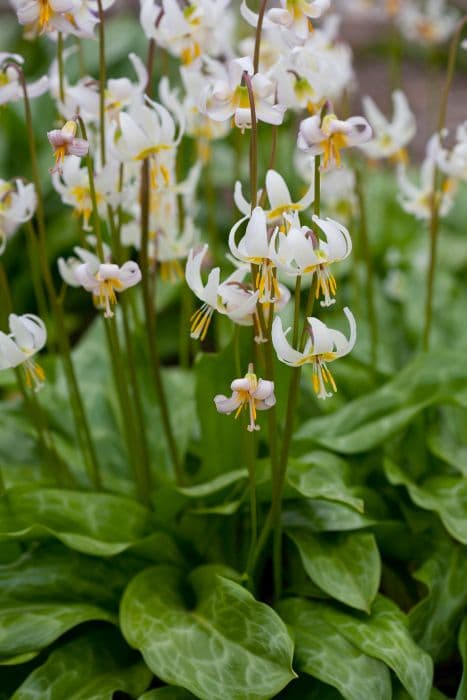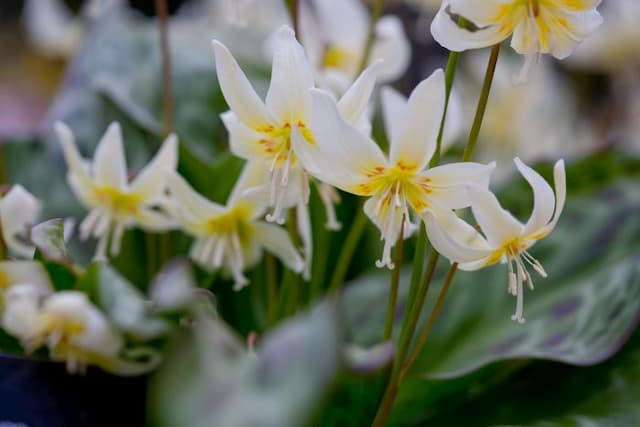Dog's-tooth violet Erythronium 'Janice'

ABOUT
Erythronium 'Janice', commonly known as the 'Janice' dogtooth violet, features a striking appearance that adds charm to garden spaces. This plant comes to life with elegant, nodding flowers that boast a unique color palette. Each blossom consists of six reflexed petals, curving backward gracefully like a turban. These petals typically display a rich pink hue at their bases, transitioning into a soft, creamy pink towards their tips. Adding to the allure, the inner petal surfaces are often adorned with a brush of deeper pink or lavender, speckled with darker spots near the petal bases. Encircling the blooms are long, slender stamens with anthers carrying pollen, which stand out against the petals' delicate coloring. In the center, the style arches elegantly, further accentuating the flower's symmetry and beauty. Below the blooms, the foliage of the 'Janice' dogtooth violet provides a lush backdrop. The leaves are glossy and green, each leaf exhibiting a distinctive shape with a wavy margin and sometimes displaying fetching mottled patterns of maroon or brown against the green. Together, the fluttering flowers and attractive foliage create a captivating display in springtime gardens, making the 'Janice' dogtooth violet a cherished addition for its ornamental appeal.
About this plant
 Names
NamesFamily
Liliaceae
Synonyms
Janice Dog's-tooth Violet, Janice Trout Lily, Janice Dogtooth Violet, Janice Adder's Tongue
Common names
Erythronium 'Janice'.
 Toxicity
ToxicityTo humans
Erythronium 'Janice', commonly known as dogtooth violet, is not typically known to be toxic to humans. However, as with any plant, individual sensitivities can vary, and it's always best to avoid ingesting any parts of ornamental plants unless they are known to be edible. If a person has a specific allergy or sensitivity, they might experience mild stomach upset, but there is no well-documented toxicity associated with this plant in humans.
To pets
Dogtooth violet is not commonly listed as toxic to pets such as cats and dogs. Pets may sometimes experience mild gastrointestinal upset if they ingest parts of this plant, particularly if they consume large quantities. Typical symptoms might include vomiting or diarrhea, but significant toxicity is not expected. If you suspect your pet has ingested a large amount of this plant and is showing adverse reactions, it is advisable to consult with a veterinarian.
 Characteristics
CharacteristicsLife cycle
Perennials
Foliage type
Deciduous
Color of leaves
Green
Flower color
Pink
Height
1-2 feet (30-60 cm)
Spread
1 foot (30 cm)
Plant type
Bulb
Hardiness zones
4
Native area
North America
Benefits
 General Benefits
General Benefits- Aesthetic Appeal: Erythronium 'Janice', commonly known as the Dog's-tooth Violet, adds vibrant color to gardens with its striking yellow flowers and attractive foliage.
- Spring Interest: Blooms in early spring, providing an early splash of color after the winter months.
- Naturalizing: Can spread over time to form natural-looking drifts in woodland or shade gardens.
- Pollinator-Friendly: Attracts bees, butterflies, and other beneficial insects, supporting local ecosystems.
- Low Maintenance: Once established, requires minimal care, making it suitable for gardeners of all skill levels.
- Shade Tolerance: Thrives in partial to full shade, ideal for underplanting beneath trees or in shadowy garden areas.
- Moisture Indicator: Prefers moist soils, which can be a natural indicator of soil moisture levels in the garden.
- Companion Planting: Partners well with other shade-loving perennials such as ferns, hostas, and hellebores, enhancing garden design and biodiversity.
- Deer and Rodent Resistant: Less likely to be eaten by deer or rodents, which can be beneficial in areas where these animals are a problem.
 Medical Properties
Medical PropertiesThis plant is not used for medical purposes.
 Air-purifying Qualities
Air-purifying QualitiesThis plant is not specifically known for air purifying qualities.
 Other Uses
Other Uses- Photography Subject: Due to its striking, unique coloration and shape, Erythronium 'Janice' is often used by photographers as a subject for nature and macro photography.
- Companion Planting: Erythronium 'Janice' can be used in companion planting to enhance the visual appeal of a garden by adding a contrasting color among other flowers or shrubs.
- Wedding Decorations: The delicate and attractive flowers of the Erythronium 'Janice' are sometimes used in wedding bouquets or as part of the floral arrangements for ceremonies.
- Educational Tool: Botany educators use this species to teach students about the reproductive processes of bulb plants and the ecosystem interactions in their native habitats.
- Culinary Garnish: Though not commonly eaten, the blossoms can serve as a non-toxic, decorative garnish for salads and desserts in high-end culinary presentations.
- Textile Dye: Historically, some Erythronium species have been used to extract color for natural dyes, which could potentially apply to Erythronium 'Janice' petals or leaves.
- Art Supplies: The petals and pollen of the Erythronium 'Janice' can be used to create natural paints and pigments for art projects.
- Aromatherapy: While not traditionally used for this purpose, the light, pleasant scent of Erythronium 'Janice' could be incorporated into aromatherapy practices for a calming environment.
- Theme Gardens: Erythronium 'Janice' can be used in specialty gardens like 'Spring Ephemeral' or 'Woodland' themes to showcase their unique habitat preferences.
- Fairy Gardens: Their delicate appearance makes Erythronium 'Janice' an ideal plant for creating whimsical fairy gardens, enchanting both children and adults alike.
Interesting Facts
 Feng Shui
Feng ShuiThe plant Erythronium 'Janice' is not used in Feng Shui practice.
 Zodiac Sign Compitability
Zodiac Sign CompitabilityThe plant Erythronium 'Janice' is not used in astrology practice.
 Plant Symbolism
Plant Symbolism- Purity: Erythronium, commonly known as trout lily, is often associated with purity due to its delicate and pristine blooms.
- Beauty: The trout lily, with its striking appearance and elegant shape, can be a symbol for beauty.
- Rebirth: As a spring ephemeral, the trout lily emerges after winter, symbolizing rebirth and new beginnings.
- Modesty: With its nodding flower heads, the trout lily is sometimes seen as a sign of humility and modesty.
 Water
WaterDogtooth violets like Erythronium 'Janice' should be watered deeply once the top inch of soil feels dry to the touch, which typically means watering once a week. During the growing season, it's important to maintain consistent moisture, especially in dry conditions, but be careful not to overwater as this can lead to root rot. Depending on the size of your plant, you might end up using about 1 gallon every watering session to ensure the soil is thoroughly moistened. In the dormant season, reduce watering as the plant will require less.
 Light
LightDogtooth violets prefer partial to full shade, making them ideal for woodland gardens or shaded areas beneath trees where they can receive filtered sunlight. Direct afternoon sun should be avoided as it can scorch the leaves. A spot that receives morning sun followed by afternoon shade is often ideal for Erythronium 'Janice'.
 Temperature
TemperatureDogtooth violets thrive in cooler conditions and can survive winter temperatures as low as 20 degrees Fahrenheit, making them suitable for many temperate regions. They prefer a temperature range of 50 to 70 degrees Fahrenheit during their active growing period. Extreme heat or frost can damage the plant, so it is important to plant them in an area with some temperature stability.
 Pruning
PruningPruning of dogtooth violets is not generally required, but you can remove dead or yellowing foliage as needed to keep the plant tidy and healthy. The best time to tidy up the plant is after flowering and once the foliage has begun to decline, usually in late summer or early autumn. This helps prevent diseases and provides a neat appearance during dormancy.
 Cleaning
CleaningAs needed
 Soil
SoilTrout Lily 'Janice' thrives in a soil mix that is rich, well-draining, and humus-rich with a pH of 6.0 to 7.0.
 Repotting
RepottingTrout Lily 'Janice' does not often require repotting; it should be done every 3-4 years or when overcrowded.
 Humidity & Misting
Humidity & MistingTrout Lily 'Janice' prefers moderate to high humidity but adapts to average household levels.
 Suitable locations
Suitable locationsIndoor
Grow Trout Lily 'Janice' in bright, indirect light with cool temperatures.
Outdoor
Plant Trout Lily 'Janice' in dappled shade in moist soil.
Hardiness zone
4-9 USDA
 Life cycle
Life cycleErythronium 'Pagoda', as Erythronium 'Janice' is not a well-documented cultivar, typically begins its life cycle as a dormant bulb that sprouts in early spring. It emerges with two mottled basal leaves, followed by a single flower stalk bearing a delicate nodding bloom, usually yellow or cream in color, with recurved petals and prominent anthers. After pollination, which is often carried out by bees, the flower develops into a capsule that contains seeds. The plant dies back to its bulb after flowering and seed dispersal, remaining dormant through summer and winter. In favorable conditions, the bulb may multiply, forming a clump of bulbs over time. Seedlings may also grow from dispersed seeds, but this is less common in garden settings due to competition and less ideal conditions.
 Propogation
PropogationPropogation time
Late summer to early fall
Erythronium 'Janice', commonly known as the dogtooth violet, is best propagated by dividing its bulbs. The ideal time for this is in the late summer to early fall, when the plant has died back and is dormant. To propagate, carefully dig up the bulbs and gently separate them, making sure each division has at least one shoot or bud. Replant the divisions immediately at a depth of about 3 to 4 inches (about 7.5-10 cm) into well-draining soil, spaced around 4 to 6 inches (10-15 cm) apart to allow for adequate growth. Water the new plantings thoroughly to settle the soil and help establish the bulbs. This method of bulb division helps to maintain the vigor of the plant and also provides a way to increase your stock of the beautiful Erythronium 'Janice'.








